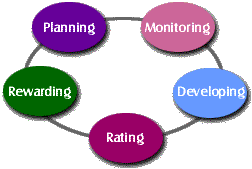Overview
Performance management is the systematic process by which an agency involves its employees,
as individuals and members of a group, in improving organizational effectiveness
in the accomplishment of agency mission and goals.
 |
Employee performance management includes:
|
The revisions made in 1995 to the Governmentwide performance appraisal
and awards regulations support sound management principles. Great care
was taken to ensure that the requirements those regulations establish
would complement and not conflict with the kinds of activities and actions
practiced in effective organizations as a matter
of course.
Additional background information on performance management can be found
in the following articles:
 |
|
| |
In an effective organization, work is planned out in advance.
Planning means setting performance expectations and goals for groups
and individuals to channel their efforts toward achieving organizational
objectives. Getting employees involved in the planning process will
help them understand the goals of the organization, what needs to
be done, why it needs to be done, and how well it should be done.
The regulatory requirements for planning employees' performance
include establishing the elements and standards of their performance
appraisal plans. Performance elements and standards should be measurable,
understandable, verifiable, equitable, and achievable. Through critical
elements, employees are held accountable as individuals for work
assignments or responsibilities. Employee performance plans should
be flexible so that they can be adjusted for changing program objectives
and work requirements. When used effectively, these plans can be
beneficial working documents that are discussed often, and not merely
paperwork that is filed in a drawer and seen only when ratings of
record are required.

|
 |
|
| |
In an effective organization, assignments and projects are monitored
continually. Monitoring well means consistently measuring performance
and providing ongoing feedback to employees and work groups on their
progress toward reaching their goals.
Regulatory requirements for monitoring performance include conducting
progress reviews with employees where their performance is compared
against their elements and standards. Ongoing monitoring provides
the opportunity to check how well employees are meeting predetermined
standards and to make changes to unrealistic or problematic standards.
And by monitoring continually, unacceptable performance can be identified
at any time during the appraisal period and assistance provided
to address such performance rather than wait until the end of the
period when summary rating levels are assigned.

|
 |
|
| |
In an effective organization, employee developmental needs are
evaluated and addressed. Developing in this instance means increasing
the capacity to perform through training, giving assignments that
introduce new skills or higher levels of responsibility, improving
work processes, or other methods. Providing employees with training
and developmental opportunities encourages good performance, strengthens
job-related skills and competencies, and helps employees keep up
with changes in the workplace, such as the introduction of new technology.
Carrying out the processes of performance management provides an
excellent opportunity to identify developmental needs. During planning
and monitoring of work, deficiencies in performance become evident
and can be addressed. Areas for improving good performance also
stand out, and action can be taken to help successful employees
improve even further.

|
 |
|
| |
From time to time, organizations find it useful to summarize
employee performance. This can be helpful for looking at and comparing
performance over time or among various employees. Organizations
need to know who their best performers are.
Within the context of formal performance appraisal requirements,
rating means evaluating employee or group performance against the
elements and standards in an employee's performance plan and assigning
a summary rating of record. The rating of record is assigned according
to procedures included in the organization's appraisal program.
It is based on work performed during an entire appraisal period.
The rating of record has a bearing on various other personnel actions,
such as granting within-grade pay increases and determining additional
retention service credit in a reduction in force.
Note: Although group performance may have an impact on an employee's
summary rating, a rating of record is assigned only to an individual,
not to a group.

|
 |
|
| |
In an effective organization, rewards are used well. Rewarding
means recognizing employees, individually and as members of groups,
for their performance and acknowledging their contributions to the
agency's mission. A basic principle of effective management is that
all behavior is controlled by its consequences. Those consequences
can and should be both formal and informal and both positive and
negative.
Good performance is recognized without waiting for nominations
for formal awards to be solicited. Recognition is an ongoing, natural
part of day-to-day experience. A lot of the actions that reward
good performance — like saying "Thank you" —
don't require a specific regulatory authority. Nonetheless, awards
regulations provide a broad range of forms that more formal rewards
can take, such as cash, time off, and many nonmonetary items. The
regulations also cover a variety of contributions that can be rewarded,
from suggestions to group accomplishments.

|
 |
|
| |
Managing Performance Effectively. In effective organizations,
managers and employees have been practicing good performance management
naturally all their lives, executing each key component process
well. Goals are set and work is planned routinely. Progress toward
those goals is measured and employees get feedback. High standards
are set, but care is also taken to develop the skills needed to
reach them. Formal and informal rewards are used to recognize the
behavior and results that accomplish the mission. All five component
processes working together and supporting each other achieve natural,
effective performance management.

|






